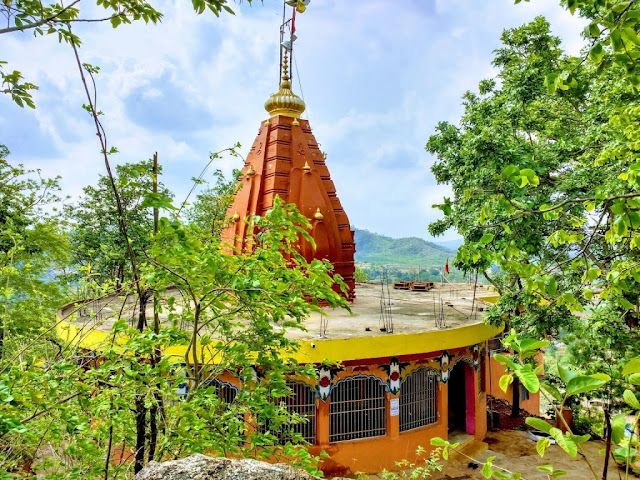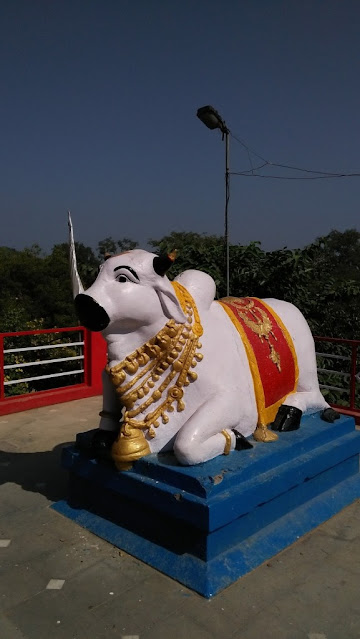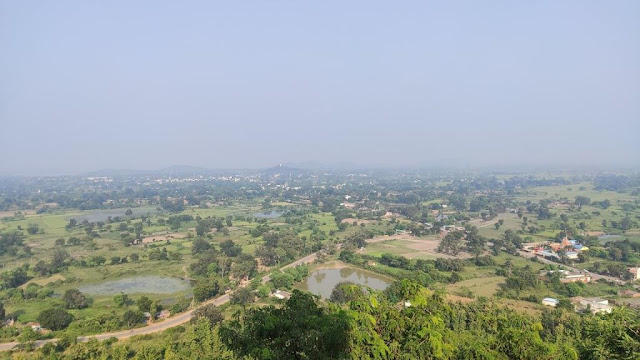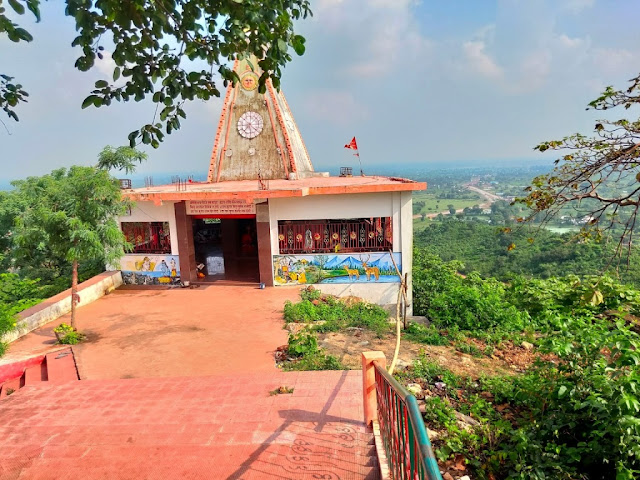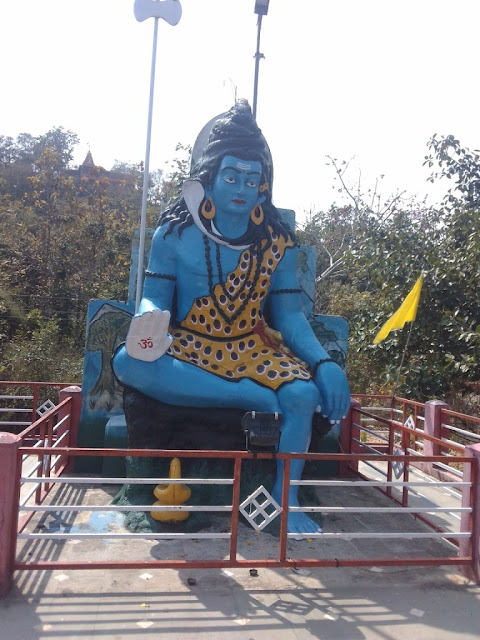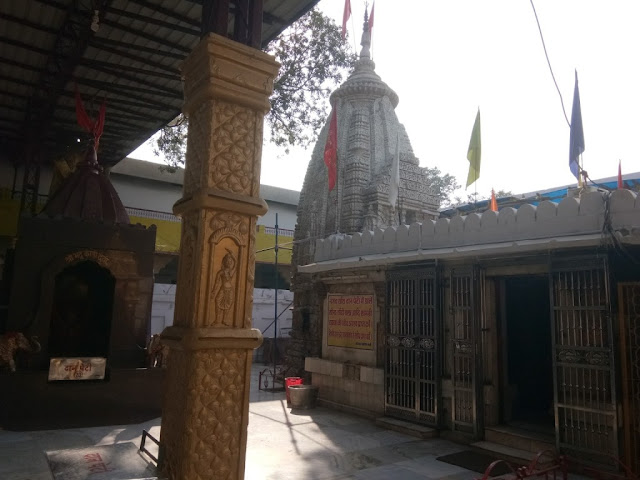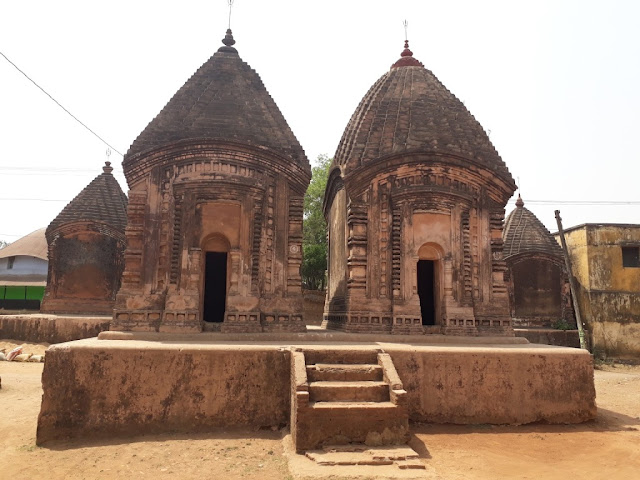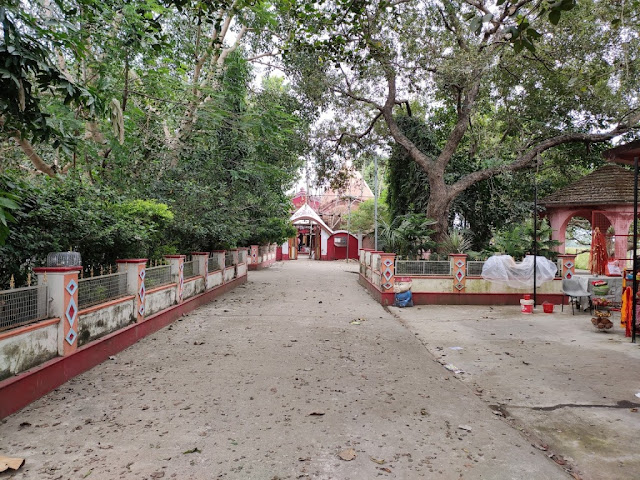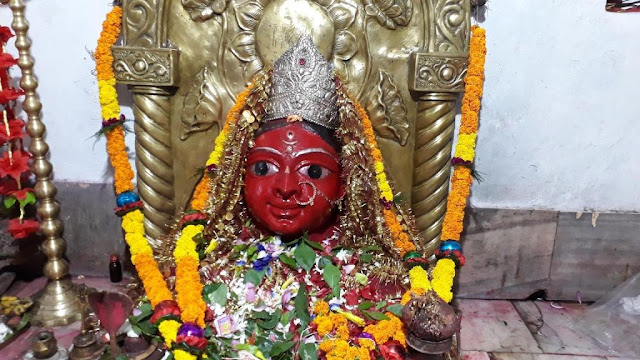Mahamaya Temple, Ratanpur –
Legends
Sakthi
Peethas:
In Hindu mythology, Daksha Yajna or Daksha-Yaga
is an important event, which is narrated in various Hindu scriptures. It refers
to a yajna (sacrifice) organized by Daksha, where his
daughter Sati immolated herself. The wrath of god Shiva, Sati's
husband, thereafter destroyed the sacrifice. The tale is also
called Daksha-Yajna-Nasha (destruction of Daksha's sacrifice). The
story forms the basis of the establishment of the Shakti Peethas, temples
of the Hindu Divine Mother. It is also becoming a prelude to the story of Parvati,
Sati's reincarnation who later marries Shiva. The mythology is mainly told in
the Vayu Purana. It is also mentioned in the Kasi Kanda of
the Skanda Purana, the Kurma Purana, Harivamsa Purana and Padma
Purana. Linga Purana, Shiva Purana, and Matsya Purana also
detail the incident.
Sati-Shiva marriage:
Daksha was one of the Prajapati, son of Brahma,
and among his foremost creations. The name Daksha means "skilled
one". Daksha had two wives: Prasoothi and Panchajani (Virini). Sati (also
known as ‘‘Uma’’) was his youngest daughter; born from Prasoothi (the daughter
of the Prajapati Manu), she was the pet child of Daksha and he always carried
her with him. Sati (meaning truth) is also called Dakshayani as she followed
Daksha’s path; this is derived from the Sanskrit
words Daksha and Ayana (walk or path).
Sati, the youngest daughter of Daksha, was
deeply in love with the god Shiva and wished to become his wife. Her
worship and devotion of Shiva strengthened her immense desire to become his
wife. However, Daksha did not like his daughter’s yearning for Shiva, mainly
because he was a Prajapati and the son of the god Brahma; his daughter
Sati was a royal princess. They were wealthy nobility and their imperial royal
lifestyle was entirely different from that of Shiva.
As an emperor, Daksha wanted to increase his influence
and power by making marriage alliances with powerful empires and influential
sages and gods. Shiva on the other hand led a very modest life. He lived among
the downtrodden, wore a tiger skin, smeared ashes on his body, had thick locks
of matted hair, and begged with a skull as bowl. His abode was Mount Kailash in
the Himalayas. He embraced all kinds of living beings and did not make any
distinction between good souls and bad souls.
The Bhutaganas, his followers, consisted of all
kinds of ghosts, demons, ghouls and goblins. He wandered through garden and
graveyard alike. As a consequence, Daksha had aversion towards Shiva being his
daughter’s companion. However, unlike Daksha, Sati loved Shiva as she had the
revelation that Shiva was the Supreme God. Sati won Shiva as her husband by
undergoing severe austerities (tapas). Despite Daksha's disappointment, Sati
married Shiva.
Brahma's Yajna:
Once Brahma conducted a huge yajna (sacrifice),
where all the Prajapatis, gods and kings of the world were invited. Shiva and
Sati were also called on to participate in the yajna. All of them came for the
yajna and sat in the ceremonial place. Daksha came last. When he arrived,
everyone in the yajna, with the exception of Brahma, Shiva and Sati, stood up
showing reverence for him. Brahma being Daksha's father and Shiva being
Daksha's son-in-law were considered superior in stature to Daksha. Daksha
misunderstood Shiva’s gesture and considered Shiva's gesture as an insult.
Daksha vowed to take revenge on the insult in the same manner.
Daksha Yaga:
Daksha’s grudge towards Shiva grew after Brahma's yajna.
With the prime motive of insulting Shiva, Daksha initiated a great yajna,
similar to that of Brahma. The yajna was to be presided over by the sage Bhrigu.
He invited all the gods, Prajapatis and kings to attend the yajna and
intentionally avoided inviting Shiva and Sati.
Dadhichi – Daksha argument:
The Kurma Purana discusses the dialogues between the
sage Dadhichi and Daksha. After the sacrifice and hymns where offered
to the twelve Aditya gods; Dadhichi noticed that there was no sacrificial
portion (Havvis) allotted to Shiva and his wife, and no Vedic hymns were used
in the yajna addressing Shiva which were part of Vedic hymns. He warned Daksha
that he should not alter the Holy Vedas for personal reasons; the priests and
sages supported this. Daksha replied to Dadhichi that he would not do so and
insulted Shiva. Dadhichi left the yajna because of this argument.
Sati's Death:
Sati came to know about the grand yajna organized by her
father and asked Shiva to attend the yajna. Shiva refused her request, saying
that it was inappropriate to attend a function without being invited. He
reminded her that she was now his wife more than Daksha’s daughter and, after
marriage, is a member of Shiva’s family rather than Daksha’s. The feeling of
her bond to her parents overpowered the social etiquette she had to follow. She
even had a notion that there was no need to have received an invitation in order
to attend as she was Daksha’s favourite daughter and no formality existed
between them.
She constantly pleaded and urged Shiva to let her attend
the ceremony and became adamant in her demands without listening to the reasons
Shiva provided for not attending the function. He allowed Sati to go to her
parents' home, along with his followers including Nandi, and attend the
ceremony, but refused to accompany with her. Upon arriving, Sati tried to meet
her parents and sisters; Daksha was arrogant and avoided interacting with Sati.
He repeatedly snubbed her in front of all the dignitaries, but Sati maintained
her composure.
Because of Sati’s persistence in trying to meet him,
Daksha reacted vehemently, insulting her in front of all the other guests at
the ceremony to which she had not been invited. He called Shiva an atheist and
cremation ground dweller. As planned, he took advantage of the situation and
continued shouting repugnant words against Shiva. Sati felt deep remorse for
not listening to her beloved husband. Daksha’s disdain towards her, and
especially her husband Shiva, in front of all the guests was growing each
moment she stood there. The shameless insult and humiliation of her and her
beloved, eventually became too much to bear.
She cursed Daksha for acting so atrociously toward her
and Shiva and reminded him that his haughty behaviour had blinded his
intellect. She cursed him and warned that the wrath of Shiva would destroy him
and his empire. Unable to bear further humiliation, Sati committed suicide by
jumping into the sacrificial fire. The onlookers tried to save her, but it was
too late. They were only able to retrieve the half-burnt body of Sati.
Daksha's pride in being a Prajapati and his prejudice
against his son-in-law created a mass hatred within himself, which resulted in
the death of his daughter. The Nandi and the accompanying Bhootaganas left the
yajna place after the incident. Nandi cursed the participants and Bhrigu
reacted by cursing the Bhootaganas back.
Destruction of the Yajna by Lord Shiva:
Lord Shiva was deeply pained upon hearing of his wife's
death. His grief grew into a terrible anger when he realized how Daksha had
viciously plotted a treachery against him; but it was his innocent wife who fell
into the trap instead of him. Shiva learned of Daksha’s callous behaviour
towards Sati. Shiva's rage became so intense that he plucked a lock of hair
from his head and smashed it on the ground, breaking it into two with his leg.
Armed and frightening, two fearsome beings Virabhadra and Bhadrakali (Rudrakali)
emerged. Lord Shiva ordered them to kill Daksha and destroy the yajna.
The ferocious Virabhadra and Bhadrakali, along with the
Bhutaganas, reached the yajna spot. The invitees renounced the yajna and
started running away from the turmoil. Sage Bhrigu created an army with his
divine penance powers to resist Shiva’s attack and protect the yajna. Bhrigu’s
army was demolished and the entire premises were ravaged. All those who
participated, even the other Prajapatis and the gods, were mercilessly beaten,
wounded or even slaughtered.
The Vayu Purana mentions the attack of Bhutaganas:
the nose of some goddesses were cut, Yama's staff bone was broken, Mitra's
eyes were pulled out, Indra was trampled by Virabhadra and
Bhutaganas, Pushan's teeth were knocked out, Chandra was beaten
heavily, all of the Prajapatis' were beaten, the hands of Vahini were cut off,
and Bhrigu's beard was cut off. Daksha was caught and decapitated, the attack
culminated when the Bhutaganas started plucking out Bhrigu’s white beard as a
victory souvenir.
The Vayu Purana do not mention the
decapitation of Daksha, instead it says Yagna, the personification of
yajna took the form of an antelope and jumped towards the sky. Virabhadra
captured it and decapitated Yagna. Daksha begs mercy from the Parabrahmam (the
Supreme Almighty who is formless), who rose from the yajna fire and forgives
Daksha. The Parabrahmam informs Daksha that Shiva is in fact a manifestation of
Parabrahmam. Daksha then becomes a great devotee of Shiva. The Linga
Purana and Bhagavatha Purana mention the decapitation of Daksha.
Certain other puranas like Harivamsa, Kurma,
and Skanda narrate the story from the perspective of the
Vaishnava-Shaiva community feud prevalent in ancient times. In these puranas,
there are fights between Vishnu and Shiva or Virabhadra, with various victors
throughout. The story of Daksha Yaga in Vaishnava and Shaiva puranas
end with the surrendering of Daksha to the Parabrahmam or with the destruction
of yajna and decapitation of Daksha.
Aftermath:
As the obstruction of the yajna will create havoc and
severe ill effects on the nature, Brahma and the god Vishnu went to
the grief-stricken Lord Shiva. They comforted and showed their sympathy towards
Shiva. They requested him to come to the yajna location and pacify the
Bhutaganas and allow the Yaga to be completed; Shiva agreed. Shiva found the
burnt body of Sati. Shiva gave permission to continue yajna. Daksha was
absolved by Shiva and the head of a ram (Male goat) meant for yajna was fixed
on the decapitated body of Daksha and gave his life back. The yajna was
completed successfully.
The later story is an epilogue to the story of Daksha
yajna mentioned in Shakta Puranas like Devi Bhagavata Purana, Kalika
Purana and the folklores of various regions. Shiva was so distressed and
could not part from his beloved wife. He took the corpse of Sati and wandered
around the universe. To reduce Shiva's grief, Vishnu cuts Sati's corpse as per
Vaishnava Puranas; whose parts fell on the places Shiva wandered. The Shaiva
version says that her body disintegrated on its own and the parts fell while
Shiva was carrying Sati's corpse in various places. It is believed that the
right shoulder of Goddess Sati fell here.
These places commemorating each body part came to be
known as the Shakti Peethas. Shakti Peethas are holy abode of the
Mother Goddess. Each temple have shrines for Shakti and Kalabhairava.
There are 51 Shakti Peethas, representing the 51 letters of Sanskrit. Some
of the puranas which came in later ages gave more importance to their supreme
deity (depending on Vaishnava, Shaiva, and Shakta sects) in their literature. Shiva
went to isolation and solitude for ages and wandered all around until Sati
reincarnated as Parvati, the daughter of the King Himavan. Like Sati,
Parvati took severe austerities and gave away all her royal privileges and went
to forest. Shiva tested her affection and devotion in disguise. He eventually
realized Parvati is Sati herself. Shiva later on married Parvati.
Ratanpur:
As per local folklore, Ratna
Deva in 1045 AD reached Ratanpur (Manipur) at evening during a hunting
expedition. He decided to spend the night under a vat tree near Maha
Maya Temple instead of returning to Tuman, his then capital. His sleep was
disturbed by supernatural light in the middle of the night. He woke up and
found the court of the Goddess Mahamaya in progress where she was present with
her attendants. He lost consciousness on seeing the court of the Goddess
Mahamaya. Next day morning, he went back to Tuman. Later in the night he had a
dream where the goddess asked him to move his capital to Ratanpur which will
result in his fame and glory. He built a grand temple
for Mahamaya in Ratanpur.

